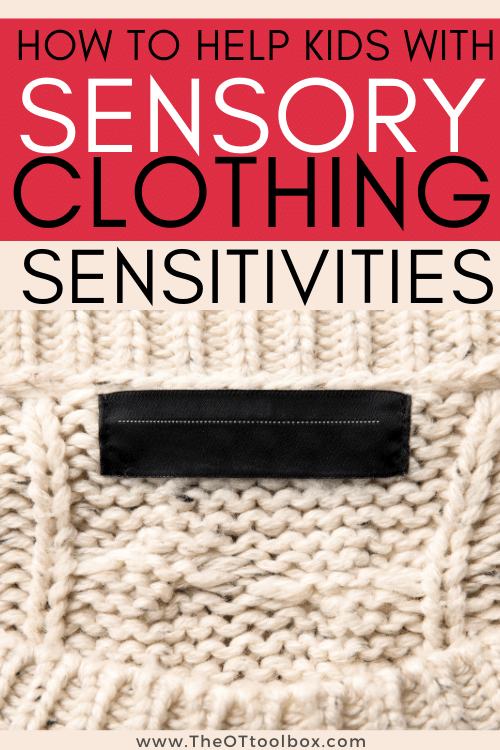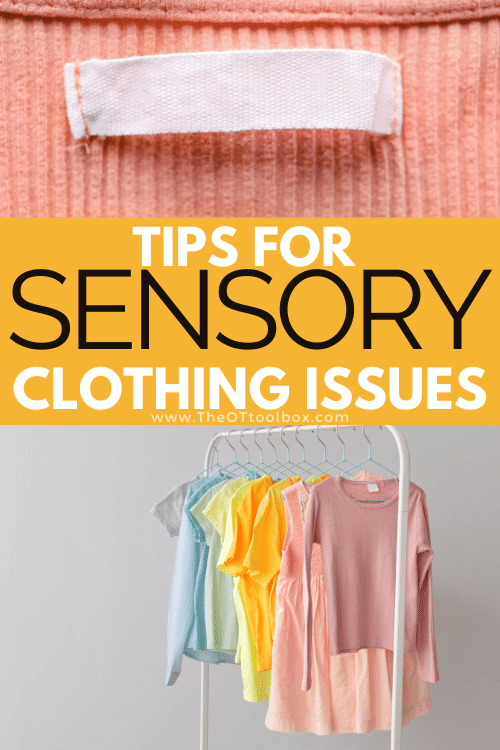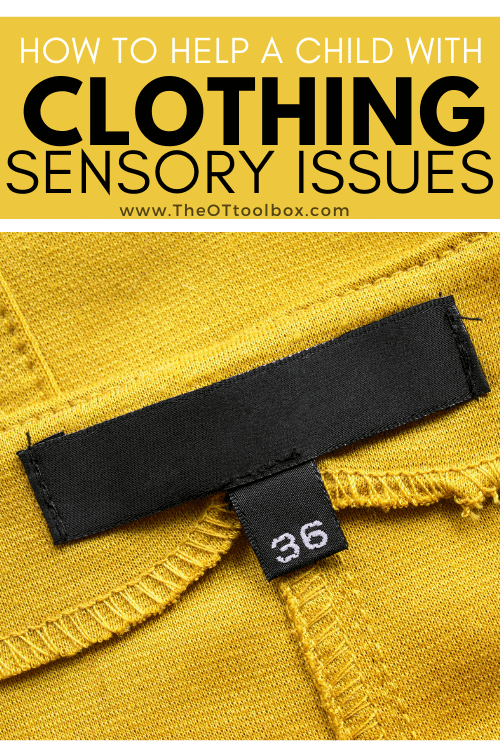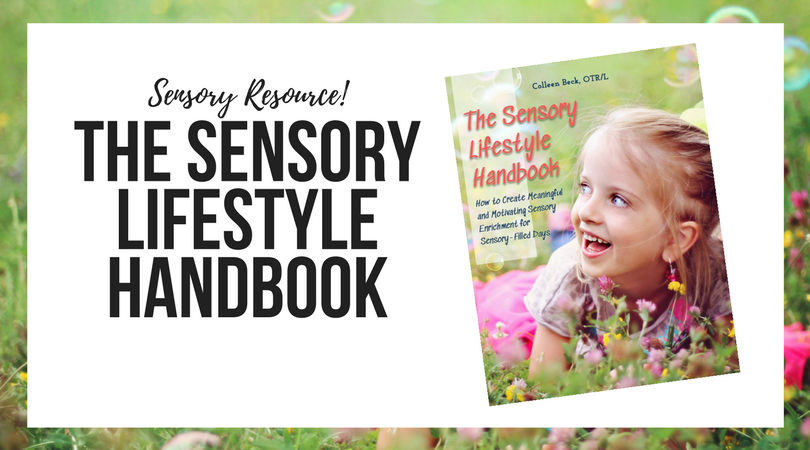Here, we’ll discuss the specific considerations for sensory issues with clothes. You’ll also find intervention strategies to support children with clothing sensitivities. The thing is that sensory processing issues for children can be highly complex and sometimes puzzling to those who do not have these difficulties. We see children that refuse to wear socks or shoes. Or we see children who will not put on pants in the dead of winter. Other kids can’t tolerate the seams of shorts or the fasteners of bras. How do you support individuals with sensory sensitivities? Let’s talk about strategies to address clothing sensitivities.

This post addresses and discusses considerations and a few possible solutions for clothing sensitivities to provide insight and areas to investigate in order to provide a child with the best possible sensory experiences with dressing and clothing as possible. The considerations are not all encompassing, but do provide valuable information in pursuit of understanding the possible reasons for clothing sensitivities for a child.
Sensory issues with clothes
Sensory issues with clothes and other sensory challenges can interfere with school, community, and home life for children who struggle with sensory processing on a daily, hourly, or even minute by minute basis. Sensory issues can be random, sporadic and happen one time, but not another despite similarities in circumstances.
A child can also have sensory sensitivities and not be diagnosed with a disorder per se, but even sensitivities have a real impact on daily functioning. Check out these clothing red flags for common sensory issues that come up again and again.
A common sensory issue reported by parents are their child’s clothing sensitivities. This involves more than the child who always wants to wear the same shirt because it has their favorite logo on it or it is their favorite color as this is more about style preference. It’s dealing more with a child who has real issues donning clothing and refuses to wear an article of clothing based on the way it feels causing the child to cry and scream and not be able to proceed with the task of dressing.
Using certain clothing preferences to address clothing sensitivities include sensory friendly clothing options.
All of us have separate sensory systems that help us register, discriminate, and process sensory input. When there is a clothing sensitivity, this is dealing with the tactile (touch) sense and how the information from that sense is sending information to our brain to process. These may show up as tactile defensiveness in some.
We have fabrics we like as they are cozy and provide us comfort and we have fabrics that are scratchy and prickly causing anxiety and keeping us on edge not allowing us to focus on much of anything else other than getting it off. Some individuals with serious sensory issues register this input as harmful and even dangerous making them want to flee or do anything to get that feeling away from them. An important thing to remember is never force a child to don something that they perceive as painful or harmful. A child’s dramatic responses, such as mentioned above, can make home life chaotic and frustrating.
Stating the obvious, dressing is a necessary part of daily living and clothing is required for a child to engage in school and community life and it helps for clothing to be worn at home even though it is not completely necessary there. With some children who do have intense clothing sensitivities, they find their home is a free place to go without clothes.
If you are a parent, these considerations can help you investigate and pinpoint the possible problem with clothing or dressing for your child. These considerations can give you valuable information to either share with your child’s OT practitioner or to pursue an assessment with an occupational therapist. Occupational therapy practitioners can provide interventions specifically directed for your child and their needs as every child is different and requires a skilled set of eyes with knowledge of your child and their needs to provide the best possible interventions and opportunity for your child’s successful daily life engagement.
Sometimes considering simple clothing anatomy for sensory sensitivities can be a good place to start, but there are other areas of clothing and the tactile (touch) sense that need to be explored a little more directly. We’ll look at both in this post.
Related: Sensory issues that impact fine motor skills can make fastening buttons and zippers a difficulty for many children.

Sensory issues with Pants
Consider: length of shirt sleeves and pant legs. The feeling of pant legs and sleeves can cause aggravation to the child’s extremities. Maybe the sounds of fabric while walking such as when wearing denim or corduroy or even the feeling of the leg fabric rubbing together while walking is enough to irritate.
Consider: elastic waistbands vs. zippered and buttoned pants as they may work better for the child. Elastic can provide more flexibility and comfort for some children. Does the waistband roll down or bunch up or are there hidden adjustable waist band apparatuses? Adjustable apparatuses can be cut out by an adult if necessary.
Consider: if there are tags or buttons sewn into the seam of pants of shorts. A tag at the back of pants can cause irritation. These can be removed by cutting out or purchase tag-free clothing.
Consider: certain textures may be more irritating to the skin or even possibly pulling arm or leg hair. If older, shaving legs can help. If the texture feel is the difficulty, purchase clothing with more soft and natural materials.
Sensory issues with shirts
Consider: The length of shirt sleeves. The feeling of sleeves can cause a tight sensation in the arm pits or around the neck, elbows, or wrists, causing aggravation to the child’s extremities. Clothing can feel too tight in the trunk.
Consider: length of shirt tails as they can be drafty if short, especially when sitting.
Consider: if the clothes are too tight or too loose. Do they sway or shift when they move? Does the fabric bunch up in the arm pits or at the wrists from being too big? Purchase clothing with the fit that is preferred for size and pressure, maybe they like tight vs. loose.
Consider: graphics on shirts and get one-dimensional graphics if necessary therefore no sequins, gems, puffy pieces, etc. are impacting the child.
Consider: if the seams in clothing are large or thick with too much fabric inside the clothing causing discomfort. Check this before you purchase clothing items. Purchase seamless clothing or turn clothing inside out as appropriate.
Consider: the pulling of hair as a shirt is pulled over the head or being too tight of a neck hole causing irritation. Purchase button up shirts vs. overhead shirts.
Consider: some clothes may be more uncomfortable to wear due to the feel of waistbands, cuffs, or collars. Explore if they are too tight, too loose, ribbed or simply hemmed. Maybe a certain type is preferred over another. Purchase no collared clothing or lightly hemmed cuffs vs snug-fitting, ribbed cuffs.

General Sensory Considerations with Clothing
Sensory issues with clothes can look different for every individual. But, there are some common similarities that make helping those with clothing sensitivities more comfortable and functional. Try these general considerations:
Consider: some clothing may be hotter or even colder to wear.
Consider: how clothes fit and adhere to the body when sitting vs. standing. Also, check regarding static cling in different seasons and purchase cling free dryer sheets to help when drying clothes.
Consider: layers of clothing to keep warm rather than wearing a jacket.
Consider: the smell of the clothing. Is the smell of the detergent, fabric softener or dryer sheet too strong for the child to tolerate? Purchase odorless detergent, softener or dryer sheets.
Consider: the color of the article of clothing, if they’ve had a bad experience with a certain color, it could be recalled for every article of clothing that color.
Sensory Socks and Shoes
Issues with wearing socks or shoes is a common concern for those with sensory challenges.
Consider: checking sock seams and the position on the toes. How do the socks fit? Are they a good size, too tight, too loose, too short, or too long? Have the socks stretched and become ill-fitting? Purchase seamless socks or wear them inside out.
Consider: if socks are smooth or have fuzz ball lent on them. Are they nylon or cotton fabric, thick or thin? Purchase socks that do not gather fuzz balls as they are washed.
Consider: if toe nails are scrapping the fabric when donning. Do the shoes “eat” the socks when walking causing them to ball up under the heel? Cut the toe nails and purchase socks that do not get pulled under the heel.
Consider: shoe comfort such as width, size, and how high the backs are. Are the shoes too tight or too loose? Purchase shoes that have an open heel.
Consider: if the tongue is twisted or shifted. Is there anything inside that could be poking or irritating the foot? Make sure to put laces through the slots on shoe tongues to keep them straight, if this is part of the shoe design.
Understand that shoes fit and feel different with and without socks and even with thick or thin socks.
Sensory Issues and Underwear
Consider: the seams in the underwear, especially in the crotch. Are the genitals comfortable? Purchase underwear without seams or fewer seams.
Consider: if they fit too loose or too tight. Maybe they prefer more tightness like boxer briefs or maybe they prefer more looseness like regular briefs. Is the waistband too high, too low, too tight or too loose on the stomach? Is the hip design too high or too low?
Consider: if they bunch up when pants or shorts are donned. Does the underwear ride the groove between the buttocks when walking or moving? Do they harbor hygiene odors?
Consider: if the child has thigh sensitivity and underwear is possibly pulling leg hair such as with boxer briefs.
Sensory Issues and Bras
Sensory issues in teens can show up in different ways than the younger years. Some considerations include the need for a bra. For kids that previously have struggled with tight or scratchy sensations with clothing, wearing a bra can be difficult. Here are some things to consider:
Consider: the fit of the bra. Is it too tight and causing discomfort from the straps, rings/sliders, under band, or underwire as evidenced by skin markings and redness? Purchase bralettes or bras that do not have these features. Maybe an athletic bra would be better.
Consider: if they are sensitive to the feel of the hook closures against the back when leaning on a surface. Do the straps brush the arm as they slide off of the shoulder causing some irritation? Does the fabric feel uncomfortable such as with lace that tends to be scratchy?
Sensory Pajamas
Sleepwear can cause a lot of issues for some children. Pajamas can be tight and compressing, which can benefit other children who prefer and benefit from compression garments. Others, however, can feel too much pressure that impacts sleep. Here are some things to consider about sensory issues and pajamas.
Consider: the fit of sleepwear. Is it too tight, too loose, too hot, too cold, too scratchy, or too silky? Is the texture of the material such as fleece, silk, nylon, cotton, spandex, etc. cause irritation or does the sound of it against the bed sheets cause sensitivity?
Consider: if wearing p.j. bottoms, do the legs of the pants ride up the leg while moving in bed causing bunching and sensitivity? Do the shirt sleeves shift up the arm when sleeping making them uncomfortable causing bunching and creases that rub or mark the skin?
Consider: if buttons cause discomfort when lying on the stomach. Do collars or tags irritate? Do ribbed cuffs or seams cause irritation?
Investigate the fabric and other issues of the bed sheets and covers. Explore the sounds, feel, temperature, fuzz balls on the fabric due to washing, smell of detergent, softener, dryer sheets, static cling, etc.
There are many ways to address these sensory sensitivities. Sometimes any number of the above solutions can help. Allowing a child to shop for their own clothing and make their own choices while acknowledging and respecting their desire and need for certain tolerated textures can help with sensory issues.
But for those with more intense sensitivities the best bet for success is looking at a sensory diet tailored to their direct needs. If you are a parent, contact an occupational therapist for assistance. They are available to assess, treat, and consult regarding your child’s specific sensory needs. Often times, sensory sensitivities can be significantly reduced or even completely eliminated with proper treatment.
In the Sensory Lifestyle Handbook, we cover various options to address sensory issues in children and teens. You’ll find in this comprehensive resource, strategies to implement a motivating and meaningful sensory diet that is integrated right into day-to-day activities and tasks in order to create a lifestyle of sensory solutions.
Read more about the Sensory Lifestyle Handbook here.
How to support children with clothing sensitivities
If you are an occupational therapy practitioner, below are some activities or intervention ideas which can help support a child with their tactile sensitivities. Be sure to go through the considerations listed above to investigate where clothing sensitivities are stemming from in regards to specific clothing. This step can help with finding clothing styles and types that meet the needs of the individual child.
1. Explore a variety of fabrics on the skin by using fabric swatches – increase time as tolerated.
2. Desensitize skin with lotion rubbing prior to donning clothing.
3. Use whole body deep pressure activities.
4. Present a variety of textured materials by dressing a doll with various textured clothes.
5. Consider using an OT sensory brushing or pressure protocol.
6. Massage with a towel vigorously prior to introducing new textures.
7. Rub feet with lotion or towel prior to donning socks or shoes.
8. Provide textured material exploration with sensory bins
9. Provide textured floor mats for feet.
10. Explore textures using stuffed animals of different textures.
11. Suggest tight-fitting swim or biking shirt or shorts, spandex clothing or workout attire under clothes.
12. Use vibration to the extremities and back/neck as tolerated even allowing child to do this – sometimes the child will choose to do this themselves.
13. Use firm pressure activities such as rolling a therapy ball up and down the body (avoid the face).
14. Use a squeeze machine or body sock.
15. Roll child up in a bedsheet (not the face) like a taco.
16. Use firm pressure to the top of the head or up and down the arms/legs.
17. Give hugs.
18. Rub lotion on body prior to dressing as dry skin can be more easily irritated than moist skin.
19. Use a compression shirt.
20. Create a tailored sensory diet. You’ll find more information on how to create a sensory diet here.
Utilize the motivating strategies in the Sensory Lifestyle Handbook to integrate a sensory diet right into the daily life activities of each child, in a way that works for the whole family.
Click here to grab your copy of the Sensory Lifestyle Handbook.

Regina Parsons-Allen is a school-based certified occupational therapy assistant. She has a pediatrics practice area of emphasis from the NBCOT. She graduated from the OTA program at Caldwell Community College and Technical Institute in Hudson, North Carolina with an A.A.S degree in occupational therapy assistant. She has been practicing occupational therapy in the same school district for 20 years. She loves her children, husband, OT, working with children and teaching Sunday school. She is passionate about engaging, empowering, and enabling children to reach their maximum potential in ALL of their occupations as well assuring them that God loves them!







